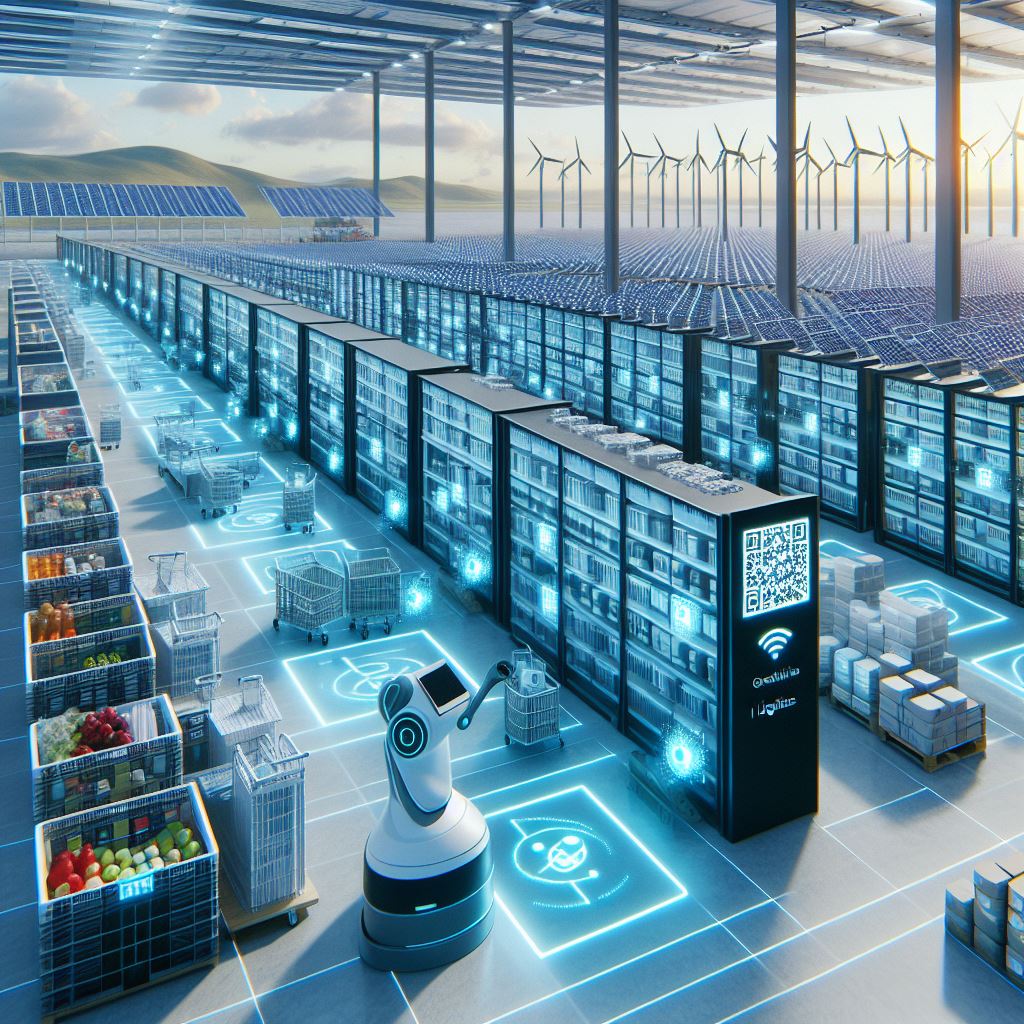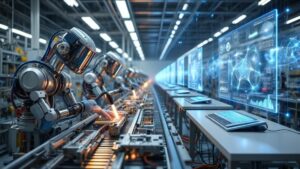Did you know that by optimizing delivery routes through machine learning, logistics companies can reduce their carbon footprint by as much as 20%. So why not utilize this resourceful tool to effectively bring down our emissions? Transportation alone is responsible for 29% of all greenhouse gas emissions in the US, and the logistics sector takes the blame for about a quarter of these emissions.
In this guide, we’ll be examining the remarkable contribution AI is making to the promotion of sustainable practices and the mitigation of the logistics sector’s carbon footprint. If you’re interested in learning more about the real-world uses of AI to reach net zero, keep reading.
Understanding the Current State of Affairs: How bad is it?
It is important to look at the status quo as it will help us grasp the amplitude of the situation we are dealing with. So let’s start by looking at some facts and figures regarding greenhouse gas emissions in the logistics sector.
- Transportation was responsible for emitting 7.97 billion metric tons of carbon dioxide (GtCO₂) in 2022.
- Of this, the US was accountable for over 21% of all these emissions (1.72 billion metric tons, with 5.1 metric tons per person)
- Medium and Heavy trucks alone account for about 25% of emissions in logistics.
- Emissions from air cargo account for 2% of the overall emissions.
- Maritime shipping causes 4% of the total greenhouse gas emissions.
All this data can help us visualize the dire straits of our environment. But there is hope. With the promising power of Artificial Intelligence, we might just be able to tip the entire situation.
So how can AI help us achieve Net Zero? Let’s take a look at the innovative ideas companies are applying AI to cut down on GHG.
1. Optimized Route Planning
It is estimated that we can reduce our emissions by as much as 10% if we plan the routes of our vehicles smartly. AI can help us achieve this with its extraordinary computational powers to analyze traffic, data, weather conditions, and other variables; aiding us in mapping out the best possible ways to transport goods and services, while cutting down fuel usage.
Currently, FedEx has been implementing AI solutions to improve its overall services, as reported by its CEO. These measures are quite promising and FedEx isn’t the only company executing these methods to cut down on emissions.
2. Predictive Analytics for Demand Forecasting
Businesses can input historical data and let AI analyze trends and patterns with the aid of AI tools to better predict future deliveries and production needs. This enables us to more effectively schedule personnel management, shipping services, and inventory levels. We can prevent any needless carbon emissions from air freight for quick supply relief by planning for these factors in advance.
3. Smart Vehicle Routing
To take things a step further, on top of route optimization, AI can now adjust routes and schedules based on real-time data, including blockages, events, disasters, and more. This can increase the efficiency of fuel usage and cut down on emissions.
The most basic example is Google Maps, helping to avoid congestion and traffic. Companies are designing further prototypes of such software
4. Efficient Fleet Management
Fleet management is the process of overseeing and managing a group of vehicles used in a business. It is easy to see the importance of an efficient fleet to obtain faster delivery time, but we often overlook how important it is to avoid unnecessary and avoidable carbon emissions. By doing so, we can:
- Reduce fuel consumption
- Lower idle time, leading to less fuel consumption
- Well-maintained vehicles are more efficient in their fuel usage
- Eco-driving practices.
Advancements in AI technology have allowed engineers to design vehicles compatible with AI. Artificial intelligence can now:
- Detect minor discrepancies that go unnoticed until they’ve turned into a bigger issue, and shoot early warnings.
- Fine-tune engine settings according to the health and condition of your equipment, providing longevity to the vehicle.
- Monitor emissions of the vehicle and apply new ideas to reduce them.
Energy-Efficient Supply Chain Operations:
1. With the aid of Artificial Intelligence, energy consumption in warehouses, distribution centers and other locations can be optimized. This can be done via various methods including:
- AI can analyze the sunlight available, and adjust artificial lighting accordingly, which can lower energy consumption.
- Monitor weather, study real-time forecast and indoor temperature and humidity levels to adjust the thermostat. Avoiding unnecessary usage of cooling or heating systems.
- Analyze data to optimize forklift routes and equipment usage, reducing fuel consumption, empty runs, and idle time.
These, among many, are just a few ways reduction in emissions is possible from warehouses. In reality, warehouses contribute to a significant portion of emissions in the supply chain and thus, addressing them is vital to sustainable operations.
To be clear, this isn’t the talk of the future, this is happening right now. Platforms like Optricity, and C3.ai are currently enforcing these solutions with noticeable results, paving the way for a greener future.
2. Collaborative Logistics Platforms
Imagine a truck on the road, half full, or even entirely empty, heading to its destination. What a waste of resources and fuel! Sadly, this is the reality for many independent businesses in the US. But there’s a way we could bypass this improvident approach, and utilize this to our advantage.
AI-powered platforms are able to match up with stakeholders in the supply chain, promoting them to share transportation, preventing empty backhaul trips, and ultimately, lowering emissions.
AI-powered platforms facilitate collaboration among different stakeholders in the supply chain, promoting the sharing of transportation resources and reducing empty backhaul trips, thus lowering emissions.
Companies like Transporeon and Truckstop are bringing this to reality by:
- Matching shipments
- Real-time collaborations (in case prior scheduling wasn’t done or things got delayed)
Enforcing these measures can greatly reduce our carbon footprint, and costs and improve energy efficiency.
1. Green Packaging Optimization
The shadow of enormous fuel and energy consumption in logistics can often eclipse the impact of unsustainable packaging in the logistics sector. AI can help engineers design strategies to massively reduce the carbon footprint of packaging. They can help us achieve this by:
- Suggest optimal packaging dimensions and shapes to minimize material usage.
- Use trends and data to predict future orders and delivery, so companies can be well stocked with eco-friendly material in times of need.
- Determine which packaging material is best for which parcel. Eg. Bioplastic, recycled paper, or edible coating.
- Design packages that also minimize the volume of the package for efficient shipping.
Applying these measures can significantly cut down on the waste produced by the logistics industry, as well as boost the brand image on the global stage.
2. Alternative Fuel Adoption: AI As A Route Planner
As we strive for Net Zero, we’ve seen promising new ideas, especially in the transportation industry. Innovations like hybrid engines and electric cars can help us move to renewable sources of energy, and pave the way to a cleaner future. But successfully transitioning to these new fuels requires more than just swapping vehicles. This is where AI steps in, becoming a crucial navigator on the road to sustainable transportation.
Traditional fuel choices often relied on intuition and past experiences. AI takes the guesswork out of the equation by analyzing vast datasets. It maps out routes, taking in factors like terrain, traffic patterns, weather conditions, and even charging infrastructure availability.
This enables logistics companies to:
- Identify optimal routes for electric vehicles by pinpointing routes with ample charging stations, maximizing range, and minimizing downtime.
- Evaluate hybrid vehicle effectiveness, analyzing driving patterns and fuel consumption to determine if hybrid vehicles are a viable option for specific routes and vehicle types.
- Plan efficient fueling strategies. For example, with alternative fuels like hydrogen, AI predicts fuel demand and suggests optimal refueling points, ensuring vehicles operate smoothly and avoid running out.
Future Outlook: AI’s Role in Greener Logistics
AI’s impact on logistics isn’t reaching a plateau, it is scaling new heights. With the way things are headed, you can expect AI to completely take over and redefine the operations of traditional logistics and supply chains. We’re not far from the future where autonomous self-driving trucks are the norm, or self-operating warehouses and distribution centers are working day and night. Other potential changes we can expect include blockchain to ensure transparency in delivery and sustainability.
AI’s role in achieving a greener future for logistics is undeniable, so it is best for companies to hop on the AI train and help the world attain a cleaner and healthier future for the next generation. Co-create your future with RTS Labs Expert guidance, empowering tools, and endless possibilities. A place where AI fuels your vision! Contact us today!
Stop dreaming, start achieving. Explore the services offered by RTS Labs for actionable strategies for turning concepts into reality with reducing our carbon footprint with AI in logistics. Learn, build, grow.






